If you are considering fertility treatment, there is a good chance that you have been frantically Googling IVF success rates.
An IVF success rate is, in a nutshell, the chances of a successful pregnancy resulting in a live birth. This figure takes into account factors including your age, the cause of your infertility, whether you are using fresh or frozen eggs and whether you are planning on using your own eggs or donor eggs.
Younger women are more likely to have a successful pregnancy. In the UK the NHS currently doesn’t recommend IVF treatment for women over the age of 42 due to low success rates. However, even though the NHS does not fund IVF for women of this age, a number pay privately for treatment and go on to have a healthy baby.
In 2019, the percentage of IVF treatments in the UK that resulted in a live birth was:
- 32% for women under 35
- 25% for women aged 35 to 37
- 19% for women aged 38 to 39
- 11% for women aged 40 to 42
- 5% for women aged 43 to 44
- 4% for women aged over 44
These figures are for women using their own eggs and their partner’s sperm, using the per embryo transferred measure.
But different fertility clinics use different methods to determine their success rate figures. These methods include calculating the number of live births per started treatment cycle, pregnancies per embryo transfer or live births per embryo transfer.
Cumulative success rates include pregnancies that occurred during the initial fresh transfer and in subsequent months, following transfer of thawed embryos, including cycles where all embryos had been electively frozen. The cumulative success rate figure is higher than the live birth rate per started treatment cycle figure because it includes the chances of having a baby from frozen embryos which have resulted from a cycle of treatment.
It is very difficult to compare clinics based on their IVF success rates as you are often not comparing like for like. So many couples turn to online IVF success rate calculators to assess their chances of success. Although these tools cannot tell you with any certainty whether your treatment will be successful, it gives you a figure which can be useful when you are looking for a fertility clinic.
If a clinic quotes an IVF success rate that is much, much higher than this figure, then you should proceed with caution, as the clinic may not be giving you the full picture.
But how accurate are IVF success rate calculators and what should you bear in mind before using one?
IVF success rate calculators – tested
In order to test these calculators fairly, we have come up with three different test subjects who we will run through each of the IVF success rate calculators. Let us introduce you to:
- Lydia:
Aged 32, Lydia previously had both of her ovaries surgically removed. She has no frozen eggs, so she will need an egg donor to get pregnant. She has not had any fertility treatment and no previous pregnancies. She is 5ft 4 and weighs 150lb.
- Sarah: Aged 44, Sarah is fit and healthy with no diagnosis of infertility. She has been trying to conceive for just over a year. This is her first round of IVF and she will be using her own eggs. She is 6ft tall and weighs 150lb.
- Emily: Aged 25, Emily has a diagnosis of endometriosis. She has been trying to conceive for four years and has one failed round of IVF using her own fresh embryo. Four embryos were collected, but none were frozen. She is 5ft 4 and weighs 130lb.
For the sake of these tests, all these women will be using their partner’s sperm to conceive and there is no diagnosis of male infertility.
SART Predictor – IVF success rates calculator
The SART (Society For Assisted Reproductive Technology) Predictor is a US-based tool that has been developed based on patient data from nearly 500,000 cycles of therapy to more than 320,000 women throughout the United States since 2006.
It is straightforward to use, but there are limitations. The predictor asks no questions about the male partner and whether the user is planning to use donor sperm. It does ask whether donor eggs are going to be used, but there was nowhere that Lydia could register that she has no eggs of her own, so the prediction that she could have a live birth after one cycle using her own eggs is rather insensitive. The calculations from the predictor assume that you have not had prior IVF treatment, so Emily has not been included in these results.
Lydia:
- Donor eggs: The probability of live birth after one cycle is 51%
- Own eggs: The probability of live birth after one cycle is 42%
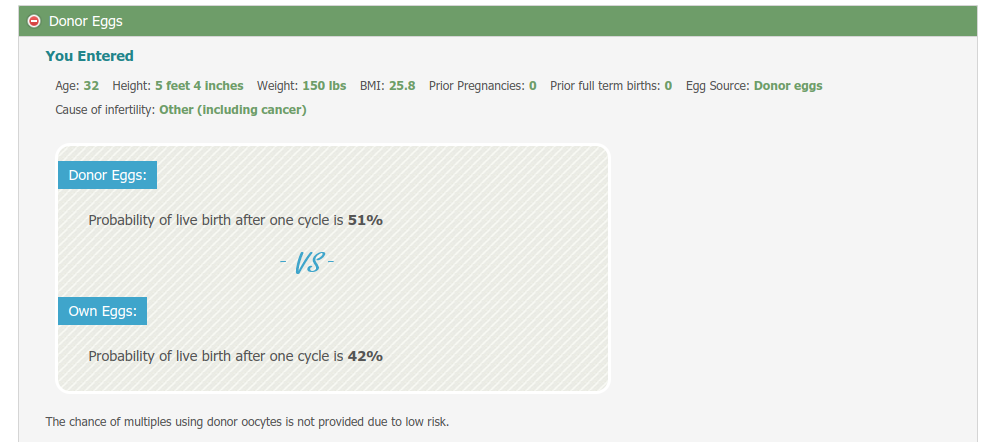
Sarah:
- The probability of live birth after one cycle is 10%
- The probability of live birth after two cycles is 17%
- The probability of live birth after three cycles is 23%
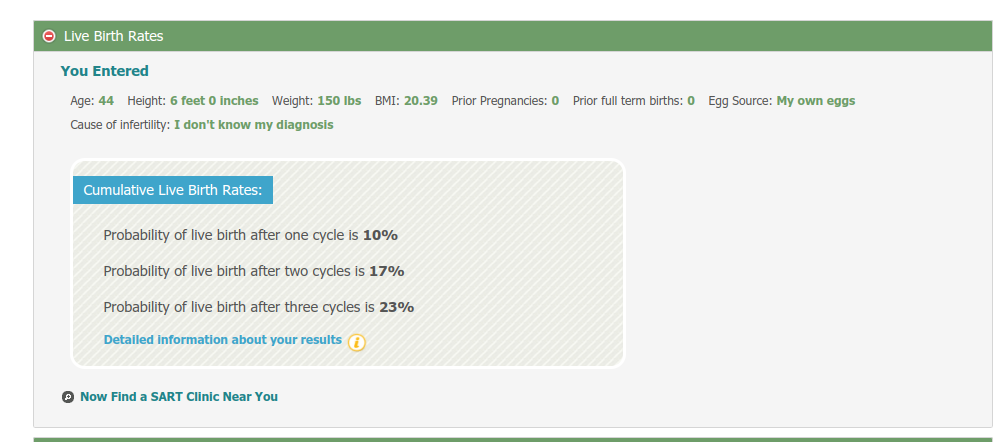
SART IVF Cycle 1 & SART IVF Cycle 2
This IVF prediction tool was developed by the University of Aberdeen using patient and treatment data from 2014-2016 from the Society of Assisted Reproductive Technology (SART) which collects and stores data on all licensed fertility treatments centres in the USA.
Before you begin your treatment, SART IVF Cycle 1 calculates your cumulative chance of having a baby over one or more complete cycles of IVF treatment. If all treatments (fresh and frozen) in your first complete cycle have been unsuccessful, SART IVF Cycle 2 will update your cumulative chance of having a baby over the second and third complete cycles.
This tool is for the use of heterosexual couples who are starting IVF treatment for the first time using their own eggs and sperm, so this means Lydia’s results can’t be counted.
A disclaimer on the website says that because fewer patients are available in the upper age group, older women like Sarah should interpret these results “with caution”.
With SART Cycle 2, Emily was not given the opportunity to volunteer her endometriosis diagnosis. She was asked about intrauterine adhesions, but although endometriosis is a risk factor for adhesions, it is not the only cause, and adhesions are not an inevitable result of endometriosis.
Sarah (SART IVF Cycle 1)
- Probability of live birth after first cycle: 9.63%
- Probability of live birth after second cycle: 14.89%
- Probability of live birth after third cycle: 18.43%
Emily (SART IVF Cycle 2)
- The probability of live birth after her second cycle is 38.56%
- The probability of live birth after three cycles is 57.17%

Check SART IVF Cycle tool here >>>
YourIVFSuccess – IVF success rates calculator
The Australian calculator, Your IVF Success Estimator, uses the main factors that are known to be associated with the success of IVF treatment. The estimate generated is based on the information you enter, and the chance of a live birth is based on women who have had IVF treatment in Australia with the same characteristics as you.
It does take into consideration previous IVF cycles, number of eggs retrieved and frozen embryos, although it is only suitable for women who are using their own eggs in treatment. Interestingly, it is one of the few calculators which asks for the age of the male partner/sperm donor.
Unlike some of the other IVF success rate calculators, this one gives you the predicted results per completed egg retrieval cycle as well as the cumulative figure.
Sarah:
- The probability of live birth after the first complete egg retrieval cycle is 3%
- The probability of live birth after the second complete egg retrieval cycle is 2% (cumulative 4%)
- The probability of live birth after the third complete egg retrieval cycle is 2% (cumulative 6%)

Emily:
- The probability of live birth after the first complete egg retrieval cycle is 34%
- The probability of live birth after the second complete egg retrieval cycle is 29% (cumulative 53%)
- The probability of live birth after the third complete egg retrieval cycle is 24% (cumulative 64%)

Check YourIVFSuccess tool here >>>
IVF Predict – IVF success rates calculator
This UK-based IVF success rate calculator is perhaps one of the most comprehensive we tested.
Unlike most of the other predictors, it asks whether you plan to use ICSI (Intracytoplasmic Sperm Injection, a treatment commonly used when male infertility is a factor). It also asks which medication you plan on using, but for those new to IVF, this may not be an easy question to answer and there is no ‘don’t know’ option. There was also no scope for Lydia to declare her lack of ovaries, as there was no ‘other’ option in the ‘cause’ section, although it does ask whether you plan to use donor eggs.
IVF Predict only gives your chance of a live birth per IVF attempt, not a cumulative result.
Lydia:
- The chance of a live birth per IVF attempt is 36.8%
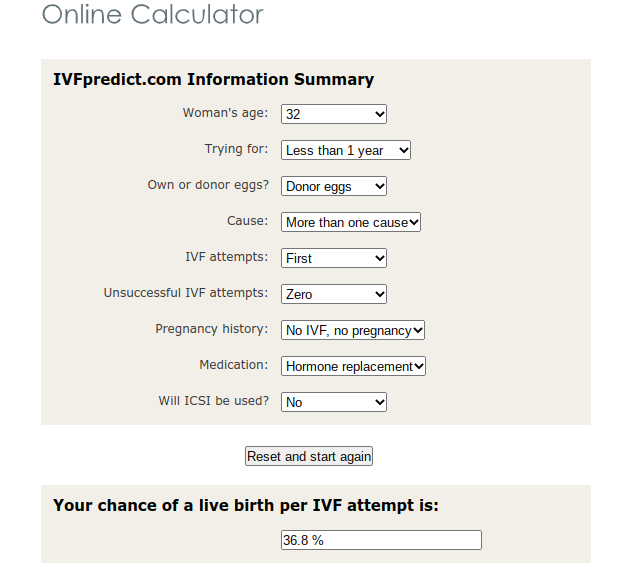
Sarah:
- The chance of a live birth per IVF attempt is 4.2%
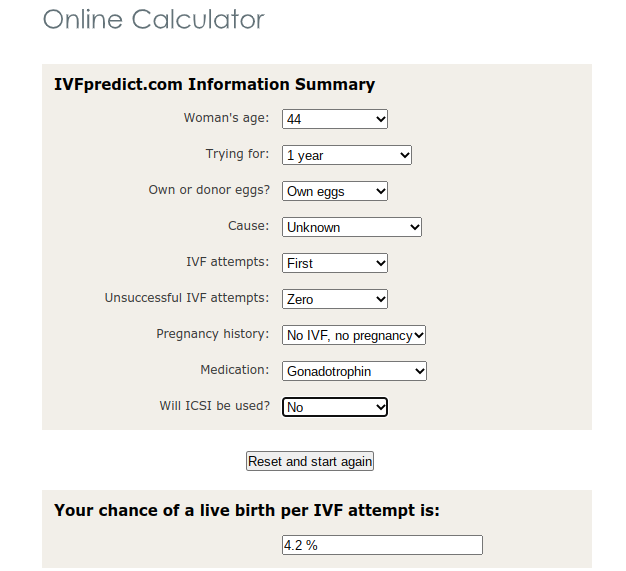
Emily:
- The chance of a live birth per IVF attempt is 21.7%
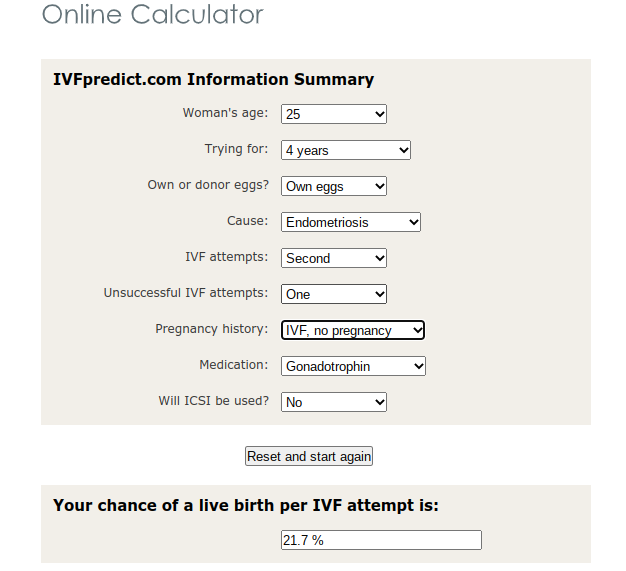
Check IVF Predict tool here >>>
OPIS predictor – IVF success rates calculator
OPIS stands for Outcome Prediction In Subfertility and this IVF success rate calculator draws on 1999-2009 data from the Human Fertilisation and Embryological Authority (HFEA) who collect and store data on all licensed fertility treatments in the UK.
There are two OPIS tools. OPIS Pre IVF calculates your chances of having a baby following one or more complete cycles of IVF treatment before you undergo any IVF treatment. OPIS Post IVF also calculates your chances of having a baby after one or more complete cycles of IVF but from the point of your first fresh embryo transfer. A complete cycle means all fresh and frozen-thawed embryo transfers resulting from one episode of ovarian stimulation.
The OPIS Pre IVF tool is nowhere near as comprehensive as the IVF Predict. There are limited options when it comes to selecting a diagnosis, with endometriosis being a notable omission, and it does not take into account women using donor eggs. As a result, Lydia’s results have not been included below.
OPIS also carries a disclaimer that because fewer patients are available in the upper age group, older women like Sarah should interpret these results “with caution”.
OPIS Post IVF is the only one that asked about the type of embryo transfer (ie day 2 or 3 or day 5 or 6) but once again there was little scope to input existing health conditions, including endometriosis.
Sarah: (Pre IVF)
- Probability of live birth after the first cycle: 5.50%
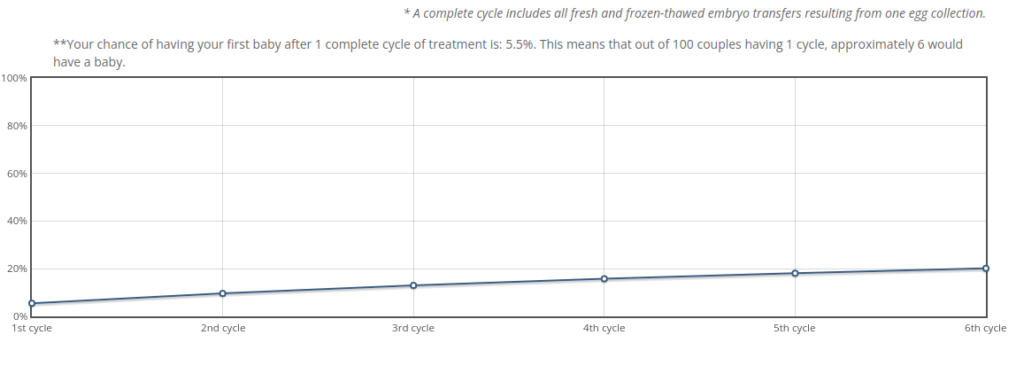
- Probability of live birth after second cycle: 9.63%
- Probability of live birth after third cycle: 12.99%

Emily: (Post IVF)
- Probability of live birth after the first cycle: 39.41%
- Probability of live birth after the second cycle: 60.56%
- Probability of live birth after the third cycle: 72.93%
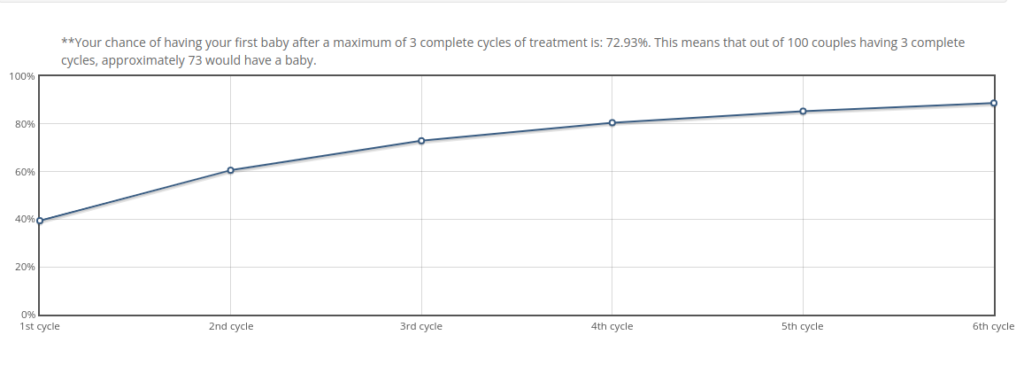
Other IVF success rates calculation tools
There are many IVF success rate calculation tools online, but these are some of the most popular predictor tools out there right now. They are impartial and clearly explain how the results are calculated and presented.
There are other calculators available, but before you use them you should check who is behind them and whether they have any commercial interests. Unlike the predictors we have reviewed here, these may ask you for personal details.
For example, the Apricity fertility clinic is behind the Apricity Fertility Predictor and will only give you your results if you enter your name and email address. And as mentioned above, different clinics measure and present their IVF success rates in different ways, which makes it difficult to compare them. We would advise using an impartial IVF success rate calculation tool which is not associated with any particular clinic or business and does not ask you to provide your name or contact details.
Let top IVF specialists review your chances of IVF success.
You can use our special tool and generate bespoke PDF-based inquiry regarding your IVF chances. The clinic of your choice may advise you of your potential treatment success rates based on your age and fertility health. Check the list of top IVF clinics abroad here >
Explore IVF Clinic Success Rates
Not all IVF calculators offer comprehensive insights, but many leading fertility clinics track success rates based on patient factors such as age and the treatment options the patients choose such as IVF with donor eggs. For example, Clinica Tambre (Spain) reports a 58% success rate with their own eggs for patients under 35, and EmBIO Medical Center (Greece) has a specialized program that increases success rates for women with certain conditions.
Final thoughts on IVF calculator success rates
Online prediction tools can be useful in giving you a general idea about your chances of IVF success and this figure can be useful when it comes to choosing which fertility clinic is right for you. However, not all of these calculators have enough input options to give you the full picture.
You should always speak to a medical professional before deciding to undergo any type of fertility treatment.
When looking into fertility treatment, IVF success rates are one of the key factors to consider. Success rates provide patients with an idea of their chances of achieving a successful pregnancy, based on factors such as age, causes of infertility, and treatment methods. Typically, younger women tend to have higher success rates,but these rates can vary significantly depending on individual circumstances.
IVF success rate calculators can give you an idea of what to expect, but their accuracy depends on numerous factors and limitations. While IVF success rates calculators can be useful tools, seeking support from fertility experts is essential throughout your journey to parenthood



